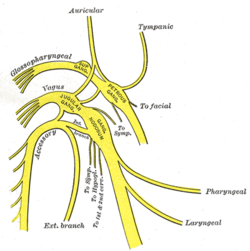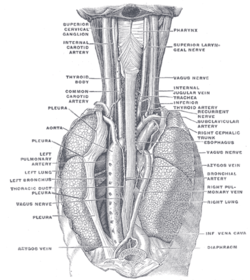Superior laryngeal nerve
| Superior laryngeal nerve | |
|---|---|
 Plan of upper portions of glossopharyngeal, vagus, and accessory nerves. ("Laryngeal" labeled at lower right.) | |
 Course and distribution of the glossopharyngeal, vagus, and accessory nerves. (Branches visible in upper right.) | |
| Details | |
| Latin | nervus laryngeus superior |
| Innervates | larynx |
| Identifiers | |
| Gray's | p.912 |
| Dorlands /Elsevier | n_05/12566088 |
| TA | A14.2.01.160 |
| FMA | 6239 |
| Anatomical terms of neuroanatomy | |
The superior laryngeal nerve is a branch of the vagus nerve. It arises from the middle of the ganglion nodosum and in its course receives a branch from the superior cervical ganglion of the sympathetic.
It descends, by the side of the pharynx, behind the internal carotid artery, and divides into two branches:
Pathology
A superior laryngeal nerve palsy changes the pitch of the voice and causes an inability to make explosive sounds due to paralysis of the cricothyroid muscle. If no recovery is evident three months after the palsy initially presents, the damage is most likely to be permanent. A bilateral palsy presents as a tiring and hoarse voice. It can be injured in surgery involving the removal of the thyroid gland (thyroidectomy).
See also
- Recurrent laryngeal nerve
- Laryngeal nerve
Additional images
-

The position and relation of the esophagus in the cervical region and in the posterior mediastinum. Seen from behind.
References
This article incorporates text in the public domain from the 20th edition of Gray's Anatomy (1918)
External links
- -2066743236 at GPnotebook
- ‹The template EMedicineDictionary is being considered for deletion.› Superior+laryngeal+nerve at eMedicine Dictionary
- cranialnerves at The Anatomy Lesson by Wesley Norman (Georgetown University) (X)
| ||||||||||||||||||||||||||||||||||||||||||||||||||||||||||||||||||||||||||||||||||||||||||||||||||||||||||||||||||||||